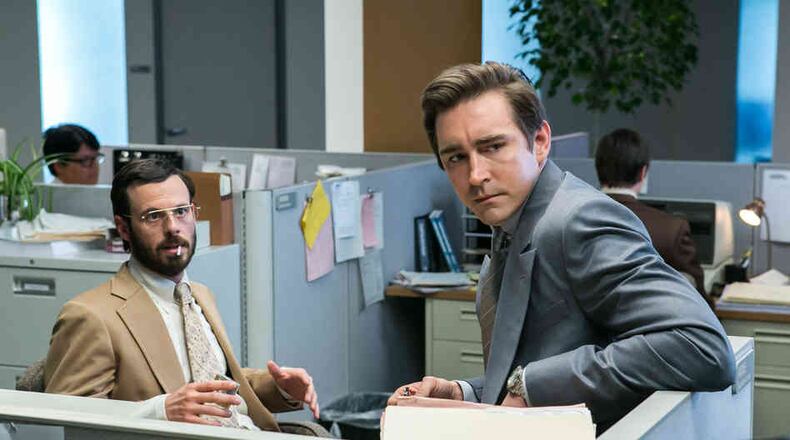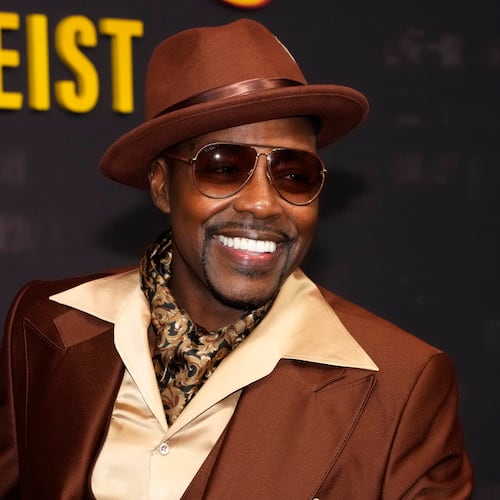With varying levels of vicissitude, Atlanta on TV has masqueraded as modern-day Los Angeles (Lifetime's "Drop Dead Diva"), Long Island (USA's "Necessary Roughness") and Missouri (ABC's "Resurrection").
AMC with its new series "Halt and Catch Fire," debuting Sunday night, took on an even greater challenge: transforming Atlanta into a convincing Dallas, Texas - in 1983. (Credit our more generous tax credits on why AMC is here and not Texas.)
"Wrong city, wrong region, wrong era," mused Melissa Bernstein, an executive producer. "Atlanta is a wonderful place to shoot but it's a new city. There are not a lot of buildings from the 1970s and 1980s."
She also had to find flat Dallas-like vistas, not an easy feat. It also took time to find a particular brick ranch home that resembled those in the Dallas suburbs. (They found one in Conyers.) And Atlanta is far more verdant than Dallas. On the bright side, most of the first season was shot during the winter. The lushness only became an issue toward the end of the shoot in March and April.
Credit: Rodney Ho
Credit: Rodney Ho
One spot that passed muster: the Plaza Theatre in Virginia-Highland, which in the pilot shows "Return of the Jedi." (The Urban Outfitters two doors down had to be CGIed into a rug store.) An office building near the Weather Channel is used for exteriors of the headquarters.
What made things easier is there wasn't a need for a huge number of outdoors scenes. "This is in large part an office drama," Bernstein said - like "Mad Men."
The set up: It's the early 1980s and the PC business is still in its relative infancy. A smooth-talking former IBM PC salesman Joe McMillan played by Lee Pace ("Pushing Daisies") arrives mysteriously from New York to Dallas and talks his way onto the sales staff of a fictional small company Cardiff Electric, a place he ultimately wants to control and do his bidding.
Joe wants to create a better PC than IBM has made. He recruits a smart, alcohol-infused hardware engineer Gordon Clark (Scoot McNairy) seeking redemption and a fetching young software coding genius Cameron Howe (MacKenzie Davis) to help him achieve his dream.
"This puts the future squarely in the hands of those who know computers not for what they are but the potential of what they can be," Joe tells Gordon at one point. "Computers are not the thing. They are the thing that gets us to the thing."
Joe, in a sense, is a bit of a wannabe Steve Jobs.
"He's a stranger in a strange land," Pace said in an interview on set in February. "He's complex and conflicted. He's a New Yorker who doesn't belong in Texas but is going to change things up. He sees computers as a tool for greater societal development. The goal of getting computers into people's hands is important to him. He's a fighter. He doesn't take things personally when he does things to piss people off."
Toby Huss, who plays Joe Bosworth, Joe's suspicious boss, is a little more blunt about Pace's character: "He's a bit of a sociopath."
Credit: Rodney Ho
Credit: Rodney Ho
At the same time, the heat between Joe and Cameron is palpable from the moment they meet. And the technology surrounding them is their aphrodisiac. In a scene I watched in a later episode, the couple play with shock pens, enjoying the voltage before getting it on with each other. "It becomes erotic," said Davis, whose looks evokes a bit of Annie Lennox and Blondie.
Despite the challenges, the show successfully captures the look and feel of the early 1980s: the Centipede arcade game in the bar (the Northside Tavern in real life), the Speak and Spell machine Gordon's kids play with, MacKenzie's New Wave haircut, the vintage Radio Shack TRS-80s. Smoking is still ubiquitous.
Credit: Rodney Ho
Credit: Rodney Ho
During the shock-pen scene, Cameron and Joe first munch on seemingly vintage Hungry Man Salisbury steak dinners. "It was meat-ish," Pace said, after consuming many many bites over multiple takes. (This was the pre-microwave version in the metal tri-compartment tray. The prop department had to create the trays out of whole cloth as well as cook their own Salisbury steak. Microwavable Hungry Man dinners didn't appear until 1986.)
"It's such a compelling story," Bernstein said. "It's really relevant today, the way technology has taken over our lives. This wasn't Silicon Valley. It was Silicon Prairie [where Compaq, Texas Instruments and Dell came from.]"
Chris Cantwell, a creator of the show who previously worked in marketing at Disney, was a toddler in 1983 but his father was a salesman in the computer business in Dallas. "The Dallas I grew up in was not the Dallas of the TV show," he said. "All my friends were transplants. There was no estate taxes and jobs were good. Dallas was blowing up. My dad worked in systems software, a company very much like Cardiff Electric."
He wanted to capture the early days when dozens of companies were making PCs before the industry consolidated. "But the show is ultimately about the people," Cantwell said. "Their ambitions and relationships with each other."
He worked hard to make sure the scripts were not anachronistic. For instance, he wanted to put in a "Rowdy" Roddy Piper reference for the first season but Piper didn't start with the WWF until 1984, a year later. "It was heartbreaking," he said, jokingly.
TV preview
"Halt and Catch Fire," 10 p.m. Sunday (starting June 1, 2014), AMC
About the Author
Keep Reading
The Latest
Featured







